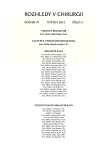Outcomes of complex therapy in female patients after breast-saving surgery for breast carcinoma at the 1st Surgical Department 1st Faculty of Medicine, Charles University and General University Hospital in Prague during a ten-year follow up period
Authors:
J. Šuk 1; I. Schwarzbacherová 1; I. Vítková 2; M. Zimovjanová 3; Z. Tesařová 4
Authors‘ workplace:
I. chirurgická klinika 1. LF UK a VFN v Praze, přednosta: prof. MUDr. Z. Krška, CSc.
1; Ústav patologie 1. LF UK a VFN v Praze, přednosta: Prof. MUDr. C. Povýšil, DrSc.
2; Onkologická klinika 1. LF UK a VFN v Praze, přednosta: Prof. MUDr. L. Petruželka, CSc.
3; Radiodiagnostická klinika 1. LF UK a VFN v Praze, přednosta: prof. MUDr. J. Daneš, CSc.
4
Published in:
Rozhl. Chir., 2012, roč. 91, č. 5, s. 267-270.
Category:
Original articles
Overview
Introduction:
Good longterm outcomes of complex therapy in operable breast cancer can be achieved mainly due to early diagnosis of the tumor, adequate radicality of surgery and adequate oncotherapy. The following outcome criteria are considered significant: long-term survival rate in complete remission, a number of locoregional recurrences and a number of reoperations or mastectomies required by results of final histological examination, patient satisfaction with a cosmetic result of their breast - saving surgery. Comparison of complex treatment results collected from patients who underwent breast-saving procedures performed for breast cancer at our department of surgery with data reported in literature.
Material and methods:
Retrospective analysis of data collected from 106 female patients suffering from invasive breast cancer and ductal carcinoma in situ operated at our surgery department from 1998 until mid-2002. The sample included nine patients who underwent surgery after neoadjuvant oncotherapy. The median follow-up time after surgery was 10 years and 7 months. Reresection was indicated based on the following criteria, set up by the authors: outline margin of less than 1 mm in invasive tumors, and in cases of ductal carcinomas in situ and carcinomatous lymphangiopathy their presence directly within the resection line.
Results:
The patient group included 13 (12.3%) patients with early reoperations. During the follow up period, locoregional recurrence was recorded in 3 (2.8%) patients. A total of 12 (11.3%) patients with generalized breast carcinoma died, their median survival was 6 years and 4 months. A total of 90 (84.9 %) patients are surviving with complete remission of the disease. Thecosmetic outcome was evaluated by patients according to a five-point scale. Out of the total of 77 surviving patients who underwent breast-saving procedures, the authors personally contacted 52 subjects (67.5 %). Out of the total, 45 (86.5 %) subjects evaluated the cosmetic outcome as excellent or very good.
Conclusion:
The survival rate with complete remission and satisfactory cosmetic results is considered to be comparable with the data presented in literature. Considering a small number of early reresections or mastectomis and locoregional recurrences our clinic achieved good outcomes.
Key words:
breast carcinoma – breast-saving surgery – reresection – recurrence – cosmetic result
Sources
1. Pleijhuis R, Graafland M, Vries J, et al. Obtaining adequate surgical margins in breast-conserving therapy for patients with early-stage breast cancer: current modalities and future directions. Ann Surg Oncol 2009;16 : 2717–273.
2. Blichert-Toft M, Nielsen M, During M, et al. Long-term results of breast conserving surgery vs. mastectomy for early stage invasive breast cancer: 20-year follow-up of the Danish randomized DBCG-82TM protocol. Acta Oncol 2008;47 : 672–81.
3. Cao D, Lin C, Woo SH, et al. Separate cavity margin sampling at the time of initial breast lumpectomy signi?cantly reduces the need for reexcisions. Am J Surg Pathol 2005;29 : 1625–32.
4. Jacobs L. Positive margins: the challenge continues for breast surgeons. Ann Surg Oncol 2008;15 : 1271–2.
5. Jobsen JJ, van der Palen J, Ong F, et al. Differences in outcome for positive margins in a large cohort of breast cancer patients treated with breast-conserving therapy. Acta Oncol 2007;172–80.
6. Riedl O, Fitzal F, Mader M, et al. Intraoperative frozen section analysis for breast-conserving therapy in 1016 patients With breast cancer. Breast J 2006;331–7.
7. Kumar R, Alavi A. Fluorodeoxyglucose-PET in the management of breast cancer. Radiol Clin North Am 2004;42 : 1113–22.
8. Fedorik GG, Sachs R, Goldfarb MA. Oncologic and aesthetic results following breast-conserving therapy with 0.5 cm margins in 100 consecutive patients. Eur J Surg Oncol 2009;32–7.
9. Cendan JC, Coco D, Copeland EM. Accuracy of intraoperative 10 frozen-section analysis of breast cancer lumpectomy-bed margins. J Am Coll Surg 2005;201 : 194–8.
10. Weinberg E, Cox C, Dupont E, et al. Local recurrence in lumpectomy patients after imprint cytology margin evaluation. Am J Surg 2004;188 : 349–54.
11. Hall NC, Povoski SP, Murrey DA, et al. Combined approach of perioperative 18F-FDG PET/CT imaging and intraoperative 18F-FDG handheld gamma probe detection for tumor localization and veri?cation of complete tumor resection in breast cancer. World J Surg Oncol 2007;5 : 143.
12. Tagaya N, Yamazaki R, Nakagawa A, et al. Intraoperative identification of sentinel lymph nodes by near-infrared fluorescence imaging in patients with breast cancer. Am J Surg 2008; 195 : 850–3.
13. Haid A, Knauer M, Dunzinger S, et al. Intra-operative sonography: a valuable aid during breast-conserving surgery for occult breast cancer. Ann Surg Oncol 2007;14 : 3090–101.
14. Tafra L, Fine R, Whitworth P, et al. Prospective randomized study comparing cryo-assisted and needle-wire localization of ultrasound-visible breast tumors. Am J Surg 2006;192 : 462–70.
Labels
Surgery Orthopaedics Trauma surgeryArticle was published in
Perspectives in Surgery

2012 Issue 5
Most read in this issue
- Prevention of TEN in surgery, prolonged thromboprophylaxis
- Pilon fractures of the tibia – a short summary of problems and case reports
- Outcomes of complex therapy in female patients after breast-saving surgery for breast carcinoma at the 1st Surgical Department 1st Faculty of Medicine, Charles University and General University Hospital in Prague during a ten-year follow up period
- Developments in pancreatic surgery at the 1st Surgical Department 1st Faculty of Medicine, Charles University and General University Hospital in Prague
